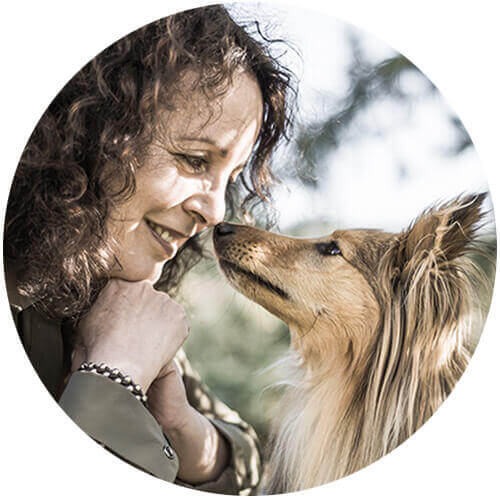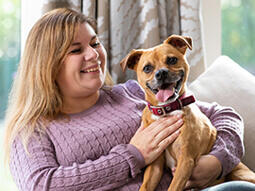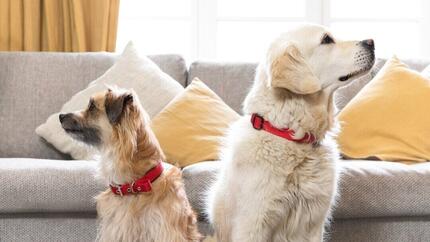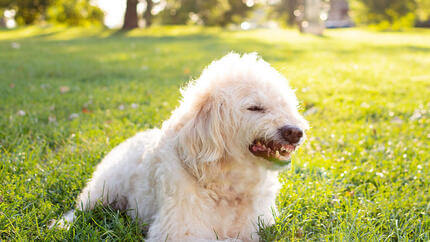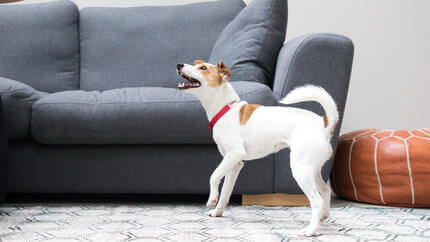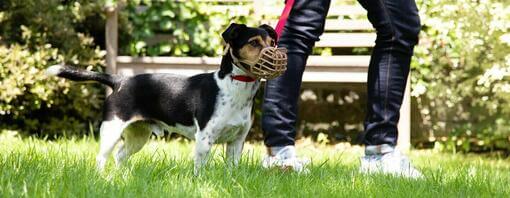
There are many reasons why your dog may be aggressive, and it may require veterinary advice. Read about the causes of aggressive behaviour in dogs here.
Your dog has a personality completely unique to them – and like all dogs, they have different moods ranging from joyful to scared. If your dog is behaving aggressively however – either to people or other dogs - you should address it as soon as possible.
Aggressive dog behaviour can include:
- Aggression to strangers
- Aggression to family members
- Guarding resources (such as food, treats or toys)
- Aggression to other dogs in the household
- Aggression to unknown dogs
If your dog is showing any signs of aggression, first of all, consult your veterinary surgeon. Your vet will conduct a full examination to see if there is a clinical reason for your dog’s aggression such as pain, discomfort or any other physical cause.
If no medical explanation or treatment can be found, the vet can refer you to a professional behaviourist for help. Take a look at your pet insurance policy - some will cover these fees for your added peace of mind.
Although taking your dog to see the vet or behaviourist might seem worrying, you should never attempt to treat your dog’s aggression yourself, or ignore it and hope it will go away. If your dog’s aggression is not tackled quickly and appropriately, the problem can escalate and may result in serious injury to yourself and your family, other people or other animals, and even legal issues – and of course, you want to get help for your dog long before it gets this far! This is a problem that is far better - and far easier - tackled straight away.
Why is my dog aggressive?
All behaviours happen for a reason and occur as a result of the way the dog is feeling – and aggression is no different. A properly qualified and experienced behaviourist will be able to get to the heart of why your dog feels they need to act in this way, what their triggers are, and how to deal with this.
The fear response
Aggression in dogs nearly always comes from fear – as the purpose of aggression for a dog is one of perceived self-defence, and nearly always is with the intent of making things the dog regards as frightening or unpleasant stop, make them go away, or prevent them from happening in the first place.
These fears can arise due to inadequate early puppy socialisation, past experiences, or the perception that valuable resources are under threat of being taken away. Some dogs who have been roughly or inappropriately handled as a puppy or put in scary situations when they are too young to be able to do anything about it can also grow up to be more reactive as adults.
Since fear is the most common cause of aggressive behaviour in dogs, you should never punish your dog for growling or any other display of aggression. Shouting at a dog for growling at something he is fearful of will simply compound his fear, may escalate the aggression, and quite likely his aggressive response will worsen next time.
What should I do if my dog is aggressive?
First of all, learn how to recognise how your dog is feeling. Every dog gives warning signals before they bite or attack – especially the first time - but owners aren’t always very good at reading them.
Dog aggression warning signs
There are several signals that your dog may give to indicate they are worried, fearful or feeling stressed, and if we recognise these, we can keep dogs feeling safe and stress-free, and so prevent a lot of canine aggression long before it starts. Often dogs bite out of self-defence because they feel that it is their only option as all their other warning signs have been ignored.
The first indications you may see to indicate your dog is feeling uncomfortable is yawning or licking their lips. You may also see them turning their head away from whatever is causing their discomfort and you might also see the white of their eye (whale eye). If you notice any of these, you should take action to remove whatever is worrying your dog or take them away from the situation.
Or you may see more obvious signals such as your dog crouching with their tail between their legs, or lifting their paw, or tensing around their eyes or mouth. Or you may notice them becoming very stiff and still. These are all dog aggression warning signs that you should take notice of. Take time to watch your dog and you will be surprised how much they are communicating how they are feeling.
Don’t assume that a wagging tail is always indicative of a friendly dog. A stiff wagging tail, or a tail wag in a dog who is crouched with lowered body language can all be warning signs that the dog is conflicted, fearful or worried.
The next stage may be your dog growling – and for many people this is the first time they notice something is wrong but for the dog, this is almost a last warning. Growling is a vocal way a dog can express that they are feeling fearful or aroused, and it’s a very clear warning that they will in all likelihood escalate their behaviour to a bite if the situation does not change. We should be looking to prevent our dogs from feeling uncomfortable enough that they have to tell us with a growl but if they do, listen to them!
If your dog feels that they are going to be punished for growling, they may stop doing so in the future but they will no longer give you that last warning and may instead move straight to the next level - which is to bite.
How to help a reactive dog
- Remove the source of your dog’s stress, fear or arousal – or take your dog away from the situation.
- Act to prevent the situation from happening again. As an example, if he is growling because he doesn’t like someone approaching him when he is eating, then make sure he is fed in a room on his own until you can seek professional advice.
- All dogs are different and are worried by different things so learn to observe your dog so you can tell how they are feeling – and so how they are likely to behave. Most aggression only happens because owners unwittingly put their dogs in situations they can’t cope with.
- If aggression becomes a regular behaviour or if you are concerned it might do, or if you feel threatened by your dog in any way, seek professional help immediately.
- If your dog shows any of the behaviours detailed above when approached by a child, immediately remove the child and avoid all encounters with children while you seek a referral to a behaviourist. The same goes for any other people in the family or that your encounter. Never take chances with anyone’s safety – it’s better to be safe than sorry!
- Seek professional advice sooner rather than later for all cases of aggression.
How can I manage an aggressive dog?
Do not try and deal with canine aggression yourself. Find an accredited experienced behaviourist to help you. They will be able to advise on a behaviour modification programme to help and also teach you how to keep everyone safe from your dog.
The first part of managing your dog’s behaviour is to think about the safety of yourself and others. If your dog is aggressive to people when outside, or to other dogs on walks, keep them on a lead and consider training your dog to wear a muzzle when you are outdoors or in public.
If you cannot control your dog on a lead you should not take them out in public until you can seek urgent professional help. This can increase your dog’s frustration but safety comes first: instead exercise and play with your dog in a secure garden, work on your training using reward-based methods, and give them lots of mental exercise using enrichment toys and games. This will help work some energy off and improve your bond in safety until a behaviourist can help you.
If your dog is aggressive to visitors to the home, make sure you secure your dog in the garden or a secure room before you open the door or greet guests. Some dogs are only a problem when people come into their perceived territory and so be especially careful at doorways, gates and even the doors to the car.
If there is aggression between dogs in your home, keep them in separate rooms and walk and feed them individually until you get some professional help.
Not all dogs are destined to be the best of friends - your dog might show aggression towards other dogs – either out and about or in the home to their canine family. If a fight does break out between two dogs, NEVER attempt to separate them with your hands - in the confusion, you could be seriously bitten. Your safety should come first, so keep a good distance away, as it is possible for your dog to redirect their aggression towards you.
Dog fights often sound and look worse than they are and in the vast majority of cases the dogs will ultimately separate of their own accord. If the fight is showing no sign of stopping and you can intervene with no risk to yourself, then try to distract them, perhaps by ringing the door bell, throwing water at them or a towel over them, or making an unexpected loud noise such as clanging a metal pan with a wooden spoon. That brief second of startled surprise could give one of the dogs the chance to remove themselves from the fight.
One of the most difficult cases of dog aggression to treat is fighting between female dogs in the house. Although most female dogs happily co-exist in the same home, sometimes they never see eye to eye and will squabble and then fight very seriously over just about anything - food, attention, sleeping arrangements and more - and the only and most humane solution is to rehome one of the dogs for everyone’s safety and peace of mind. While owners are often resistant to this as a solution, dogs in this situation are permanently in a high degree of stress and it really is the best solution for everyone.
This is why it is preferable, if you want two dogs, to have a male and a female, ideally of two entirely different breeds/types, and ages. The more different two dogs are, the most likely they are to get on as they enjoy different things and are less likely to be competitive or value the same resources. Two dogs of the same sex and of the same breed can spell trouble for the future, as they will value the same things and so canine squabbles can often break out and which can escalate to more serious fights.
Understanding your dog’s reactivity
Just like us, our dogs can have good days and not-so-good days.
Imagine you’re one of three people in the back of a small car, without air conditioning, driving at speed along the motorway on the hottest day of the year. The windows are open so the music has been turned up and the only way you can all communicate is by shouting.
‘Please, could you turn the music down a little bit?’ you ask, but the driver ignores you.
‘Come on, I’m getting a headache, could you just turn it down a bit?’ you plead, but once again, the driver ignores you.
Finally, your voice rises above the sound of the stereo; ‘JUST TURN THE MUSIC DOWN WILL YOU!’ and the driver responds, ‘alright, no need to shout.’
When we’re stressed, overwhelmed and our requests for help are ignored we might not respond in a way that we normally would but we’re not labelled as ‘aggressive’.
Do we give the same consideration to our dogs when they behave in a way that could be labelled as ‘aggressive’?
Remember that our dogs are living in a human world, with confusing social etiquette, a language they don’t understand and strict rules and regulations that limit their freedom.
If only they could tell us that they’re stressed, overwhelmed and having a bad day.
The ladder of dog aggression
Veterinary Behaviourist, Kendal Shepherd, has detailed the different ways in which dogs communicate that they’re stressed. Many owners don’t realise how unhappy their dog is until they show their teeth, growl or bite, but there are usually lots of warning signs long before then and it’s rarely ‘out of nowhere’.
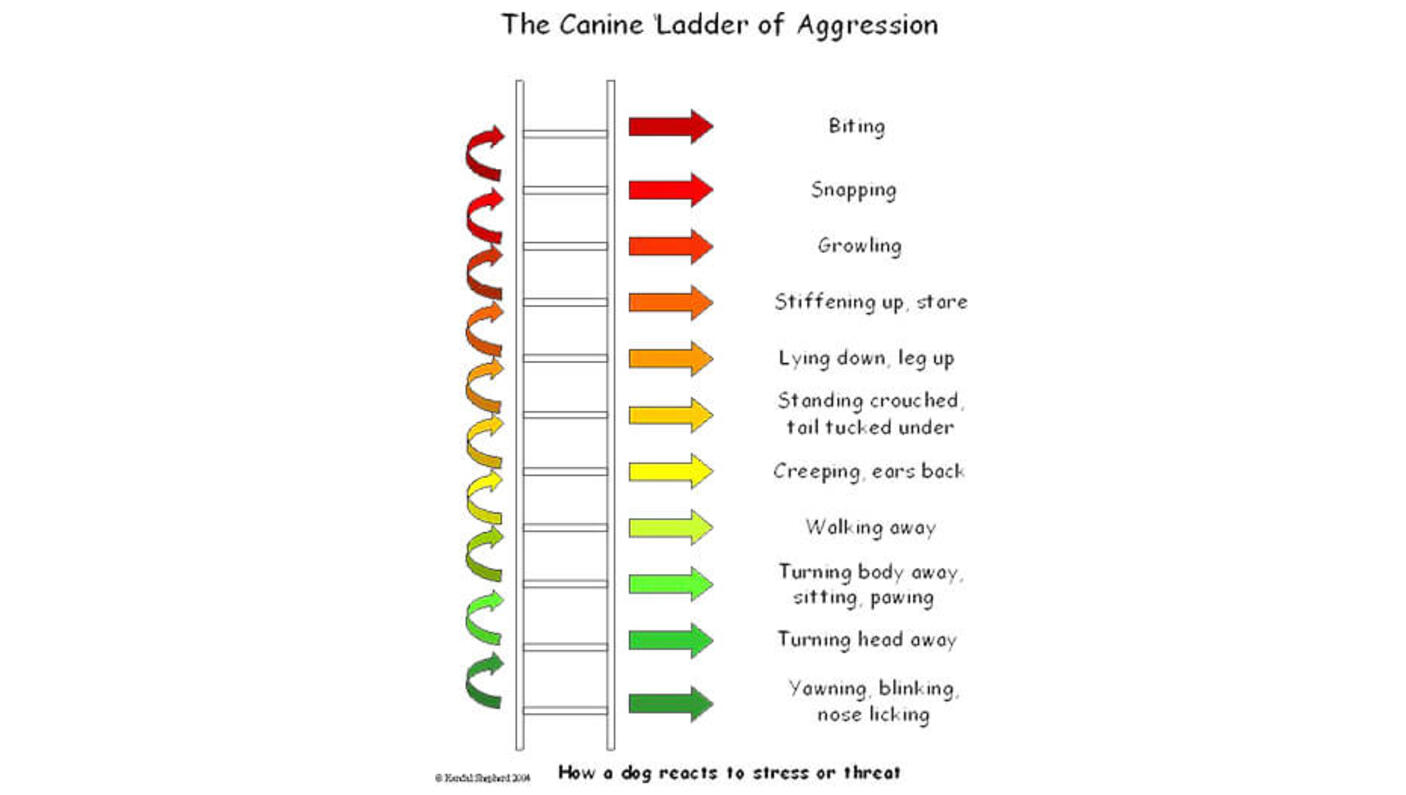
If you can spot the early warning signs that your dog is unhappy, you can quickly diffuse the situation and make sure they’re safe. By listening and responding to their communication, you’re also teaching them that you can be trusted which is vital for the bond that you share. The aim is to make sure that your dog doesn’t feel they have to move up the ladder in order to make their feelings known.
Along with your dog’s comfort and safety, another reason why it’s important to be aware of the early warning signs is so that your dog keeps using them when they need to. If your dog knows that by turning their head away and shifting their body language you will offer your help, that means they won’t need to climb the ladder. If those early warning signs are repeatedly ignored and you don’t help them until they growl or snap, then they’ll soon learn that growling or snapping is the only way to make their feelings heard and they’ll jump straight to that rung of the ladder when they’re stressed.
As you get to know your dog, you’ll learn that they have their own version of the ladder. You’ll know the behaviours they display when they’re stressed, anxious or overwhelmed and it’s your job to be their advocate, helping them to feel safe and climb back down their ladder.
Like us, they’re responding in the only way they know how and doing their best on any given day. A dog that’s usually perfectly calm and relaxed could easily climb the ladder if they’re in an overwhelming situation, they’re in pain or they’re frightened.
The information contained in this article is not a substitute for individual veterinary or behavioural advice and is for information purposes only.
